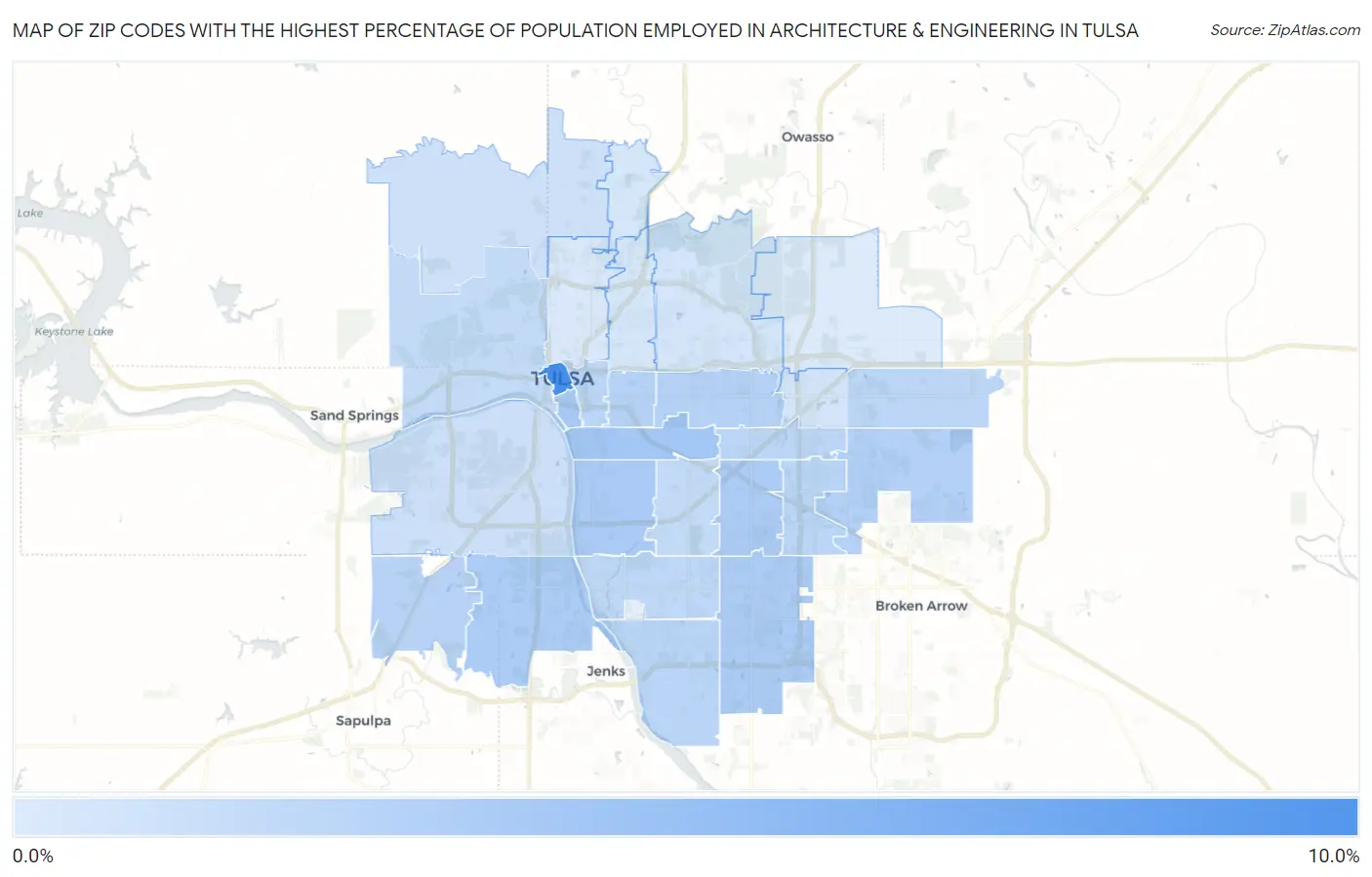Zip Codes with the Highest Percentage of Population Employed in Architecture & Engineering in Tulsa, OK
RELATED REPORTS & OPTIONS
Architecture & Engineering
Tulsa
Compare Zip Codes
Map of Zip Codes with the Highest Percentage of Population Employed in Architecture & Engineering in Tulsa
0.12%
8.9%

Zip Codes with the Highest Percentage of Population Employed in Architecture & Engineering in Tulsa, OK
| Zip Code | % Employed | vs State | vs National | |
| 1. | 74103 | 8.9% | 1.8%(+7.07)#10 | 2.1%(+6.75)#433 |
| 2. | 74114 | 3.4% | 1.8%(+1.53)#55 | 2.1%(+1.22)#4,027 |
| 3. | 74119 | 3.2% | 1.8%(+1.32)#63 | 2.1%(+1.01)#4,587 |
| 4. | 74105 | 3.0% | 1.8%(+1.21)#64 | 2.1%(+0.899)#4,897 |
| 5. | 74132 | 2.9% | 1.8%(+1.10)#68 | 2.1%(+0.793)#5,267 |
| 6. | 74145 | 2.9% | 1.8%(+1.09)#70 | 2.1%(+0.776)#5,337 |
| 7. | 74133 | 2.9% | 1.8%(+1.07)#73 | 2.1%(+0.759)#5,389 |
| 8. | 74134 | 2.5% | 1.8%(+0.652)#104 | 2.1%(+0.341)#7,040 |
| 9. | 74112 | 2.4% | 1.8%(+0.523)#111 | 2.1%(+0.212)#7,664 |
| 10. | 74104 | 2.3% | 1.8%(+0.462)#115 | 2.1%(+0.151)#7,938 |
| 11. | 74131 | 2.2% | 1.8%(+0.338)#125 | 2.1%(+0.027)#8,623 |
| 12. | 74137 | 2.1% | 1.8%(+0.291)#129 | 2.1%(-0.020)#8,871 |
| 13. | 74146 | 2.1% | 1.8%(+0.264)#132 | 2.1%(-0.047)#9,027 |
| 14. | 74120 | 2.0% | 1.8%(+0.159)#144 | 2.1%(-0.152)#9,623 |
| 15. | 74108 | 1.9% | 1.8%(+0.080)#154 | 2.1%(-0.231)#10,119 |
| 16. | 74129 | 1.9% | 1.8%(+0.055)#157 | 2.1%(-0.256)#10,294 |
| 17. | 74136 | 1.8% | 1.8%(-0.066)#166 | 2.1%(-0.377)#10,992 |
| 18. | 74135 | 1.6% | 1.8%(-0.227)#184 | 2.1%(-0.538)#12,113 |
| 19. | 74127 | 1.6% | 1.8%(-0.268)#189 | 2.1%(-0.579)#12,369 |
| 20. | 74107 | 1.1% | 1.8%(-0.745)#252 | 2.1%(-1.06)#15,903 |
| 21. | 74126 | 0.93% | 1.8%(-0.911)#281 | 2.1%(-1.22)#17,155 |
| 22. | 74115 | 0.67% | 1.8%(-1.16)#331 | 2.1%(-1.48)#19,077 |
| 23. | 74128 | 0.62% | 1.8%(-1.22)#345 | 2.1%(-1.53)#19,516 |
| 24. | 74110 | 0.51% | 1.8%(-1.33)#359 | 2.1%(-1.64)#20,188 |
| 25. | 74130 | 0.51% | 1.8%(-1.33)#360 | 2.1%(-1.64)#20,193 |
| 26. | 74106 | 0.31% | 1.8%(-1.53)#399 | 2.1%(-1.84)#21,493 |
| 27. | 74116 | 0.12% | 1.8%(-1.71)#416 | 2.1%(-2.03)#22,325 |
1
Common Questions
What are the Top 10 Zip Codes with the Highest Percentage of Population Employed in Architecture & Engineering in Tulsa, OK?
Top 10 Zip Codes with the Highest Percentage of Population Employed in Architecture & Engineering in Tulsa, OK are:
What zip code has the Highest Percentage of Population Employed in Architecture & Engineering in Tulsa, OK?
74103 has the Highest Percentage of Population Employed in Architecture & Engineering in Tulsa, OK with 8.9%.
What is the Percentage of Population Employed in Architecture & Engineering in Tulsa, OK?
Percentage of Population Employed in Architecture & Engineering in Tulsa is 2.1%.
What is the Percentage of Population Employed in Architecture & Engineering in Oklahoma?
Percentage of Population Employed in Architecture & Engineering in Oklahoma is 1.8%.
What is the Percentage of Population Employed in Architecture & Engineering in the United States?
Percentage of Population Employed in Architecture & Engineering in the United States is 2.1%.